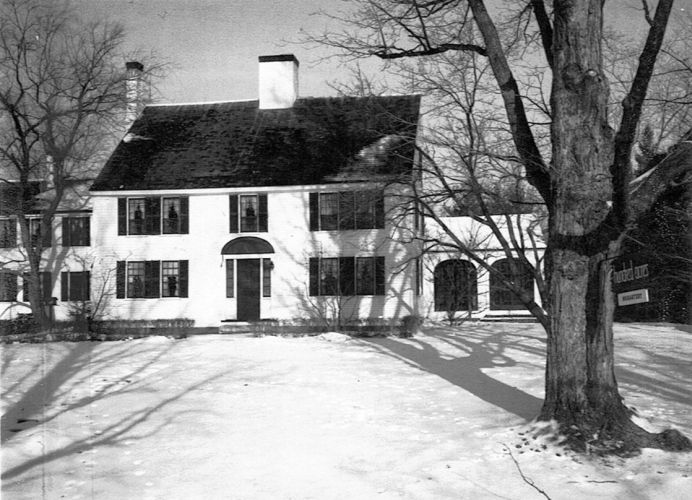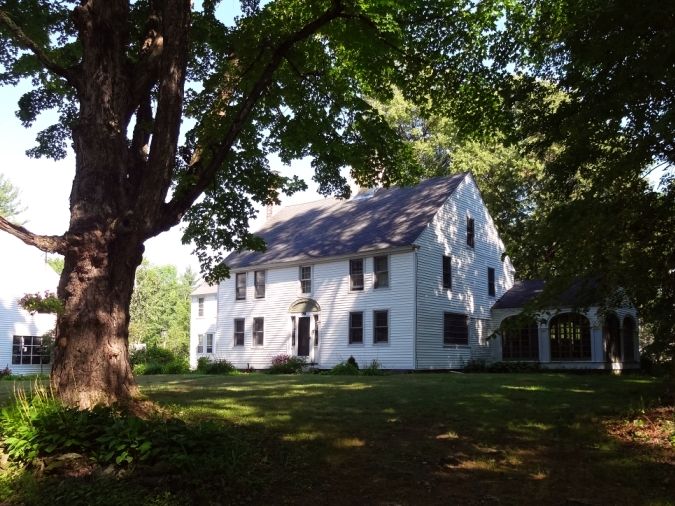New Boston Historical Society
New Boston, New Hampshire

Part 1 tells the story of this house before it became Hundred Acres Monastery
Behind the Door: 96 Scobie Road — Part 1
by Mary Atai (September 2022)
William Langdell and his son, Livermore, moved to this property in 1771. In the first 12 years, a house (still standing), a large barn, two sawmills and a grist mill were built. Mr. Langdell had 12 children. Both Livermore and his father had worked on a ship at some point in their lives. Livermore had been the captain's first mate. One of his sons, 12-year-old Jacob, drowned just down the road, in Scobie Pond, in 1813. This has prompted random mentions of hauntings over the years, and at times has caused Scobie Pond to be referred to as Haunted Pond.
At that time, this area of town was known as the "New Addition." It was land that had been allocated to New Boston, but which was later incorporated in to Francestown when the settlers living there realized it was much easier to get to church in Francestown than to trek down Route 136 and up Meetinghouse Hill to New Boston's early church.
Originally the lot was 150 acres, as were all parcels in the New Addition. It consisted of woodlands, wetlands, and meadows and the price was 120 pounds. Around 1800, Livermore sold his part of the land to Zachariah Morgan, who later bought 25 additional surrounding acres, giving him the roughly one hundred acres we know about. Livermore then moved up off Clark Hill and lived there until his death.
Zachariah was a cooper by trade and his shop was in the ell of the house, which was later used as a back kitchen. At that time there was a huge fireplace, large enough to set a barrel in it, as each one was completed, to let the wood dry out. Later, in 1864, the property was passed to his son, Zachariah Morgan, Jr. Soon Zachariah, Jr. took the grist mill out of his shop and replaced it with a planer. He began making tables. At various times the mill was used for making "flier frames" [used in textile manufacturing] and as a shingle mill. It later became the Morgan and Andrews Bedstead Factory, but then was destroyed by fire in 1883. It was rebuilt by Levi Starret and went on to manufacture bobbins. The mill was just beyond the house going toward Scobie Lake.
One of Zachariah's daughters from his second marriage to Hannah Hooper, Addie Morgan, married Jacob Langdell, who was a grandson of Livermore. Jacob had served during the Civil War and came home in very poor physical condition. Still the property remained with Jacob and Addie until 1907 and they raised 6 children there. Because there were about 100 prosperous years of ownership in the Morgan family, the farm continued to be known as the "Morgan Farm" for years afterward, no matter who owned it.

After a few years, Mrs. Wason sold the house and moved to the main street in Francestown, across from the village store.
Eleanor and Gilbert Lyons then bought and owned the property from 1945-1954 and they are the ones who named it Hundred Acres. They ran it as an inn for two years, serving buffet suppers and renting out rooms.
The property changed hands a few more times until the Monastery acquired it on December 31, 1964, from Leo and Anna Roan, who had never lived there and resided in New York.
Editor's note: Part Two continues next month.
Click here to return to the main page for "Behind the Door" articles.
